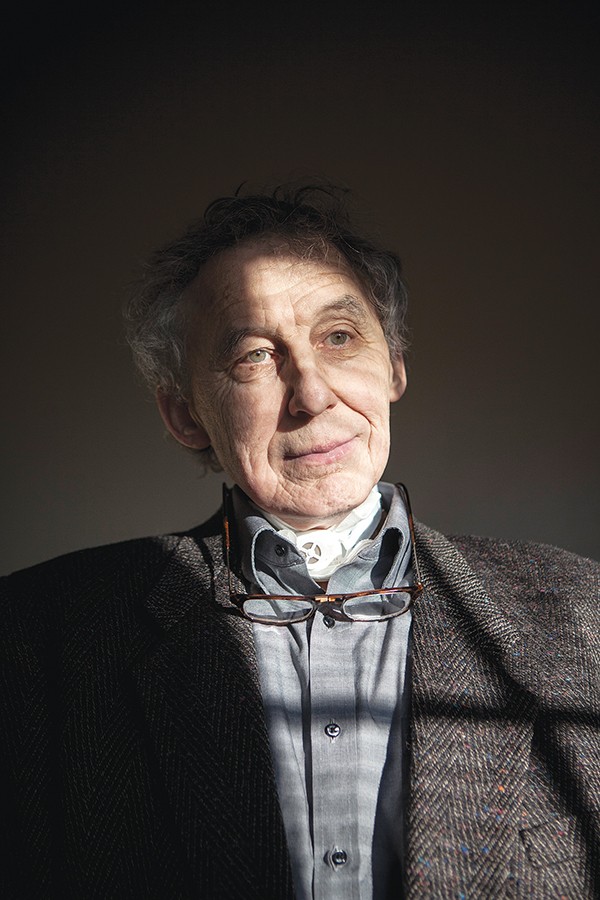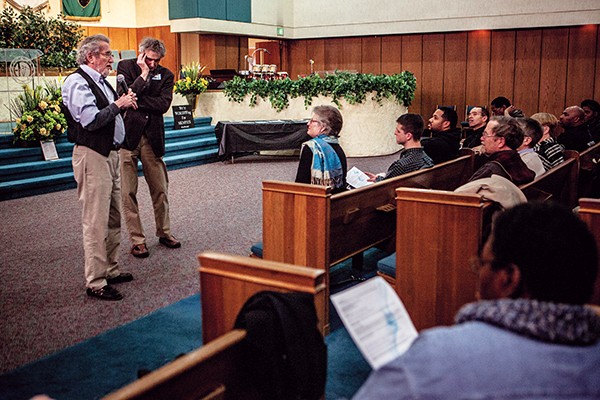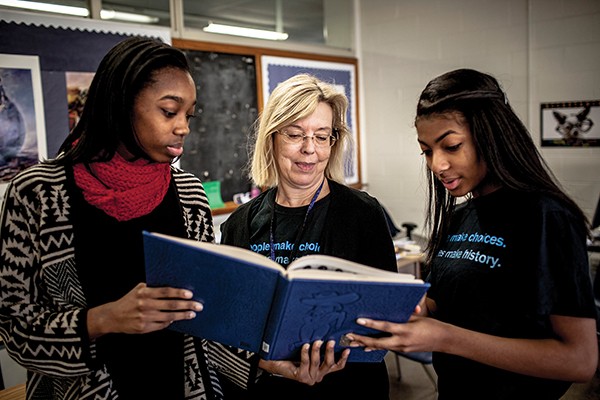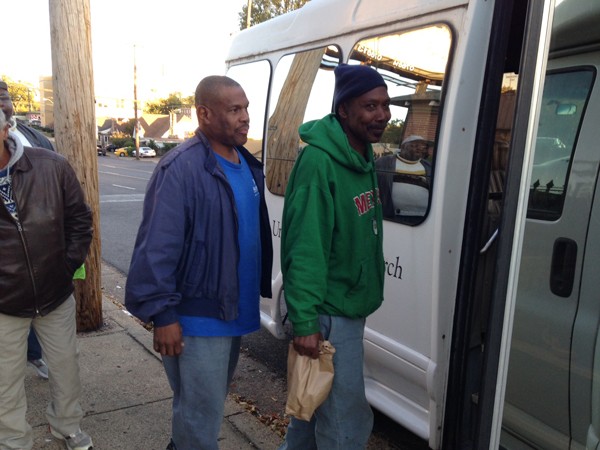Last winter, with a scrawled list of the streets and landmarks mentioned in 100-year-old newspaper articles, I drove east through Memphis, past Shelby Farms, to what I believed might have been the place where a black woodchopper named Ell Persons was burned alive before thousands of spectators. I walked along the edge of the Wolf River, unsure whether this was the place. The river was narrower than I expected, and the bridge was newer than I thought it should have been. There were no markers, no wooden crosses or makeshift memorials like I see so often marking the site of a murder or a deadly car crash. There was nothing but the wind and the winter sun warming the cool air.
The lynching of Persons is a story no one told me about my home. I never heard Persons’ name in a history class or read about the lynching in a textbook. I first encountered Persons’ story in my own reading, years after I finished high school in Memphis and moved away for college. When I went looking for the site where Persons was lynched, there was nothing to suggest whether I was in the right place.
A group of local Memphians is looking to change that. In the year since I first went looking for the site of Persons’ lynching, an as-of-yet unnamed group of ministers, professors, scholars, and churchgoers, inspired by Equal Justice Initiative founder Bryan Stevenson’s speech at the Facing History and Ourselves annual fund-raising dinner, found their mission: to identify and place historical markers at all lynching sites in Shelby County.
Though Persons was not the only victim of lynching in Shelby County, his murder is unique for its surviving details — the case was breathlessly reported in local news leading up to the lynching — and for its spectacle. Thousands of people attended Persons’ lynching, which was, according to some newspaper accounts, the first to be carried out in broad daylight.
In the spring of 1917, a 16-year-old white girl named Antoinette Rappel was found raped and murdered in Memphis, near the Macon Road Bridge. Rappel had been decapitated, her body left under a bridge along the Wolf River. Suspicion fell quickly on Persons, who lived near the site of the murder. Persons was arrested twice, interrogated twice, and released twice before being captured a third time and reportedly beaten into a confession.
In anticipation of a trial — and, ostensibly, to keep him from being lynched — local law enforcement moved Persons to a Nashville jail. As it came time for his arraignment, two police officers accompanied Persons on a train bound for Memphis. An organized mob had set up roadblocks and staked out railroad stations, looking to intercept Persons as he headed back into town. A local paper reported that passenger trains entering Shelby County were being searched by the armed mob. Persons was handed over to the mob when they discovered him on a Memphis-bound train.
Some speculate that the police gave up Persons in an attempt to avoid the riot that would form in Memphis if he was legally protected and granted a fair trial. But even if Persons had avoided the mob and made it to court, almost all local attorneys had refused to serve in his defense. Upon his capture, local papers announced he would be burned the next morning.
By eight o’clock on the morning of the lynching, reporters estimated that 3,000 people had gathered to watch. Some people had been camped out at the bridge for over 24 hours. By nine o’clock that morning, the road leading to the bridge was blocked by traffic for a mile and a half. A teacher at Central High School in downtown Memphis came to class that morning to find 50 boys absent, missing class to attend the lynching with their families. Some children brought notes from home asking that they be excused early from school in order to go to the lynching. The Memphis Press reported an old man on crutches “hobbled and bemoaned the fate that might keep him from arriving on time.” Vendors set up stands among the crowds and sold sandwiches and snacks.
 Photographs by Andrea Morales
Photographs by Andrea Morales
Clipping from a 1917 newspaper article about Persons’ lynching
Though Rappel’s mother requested that Persons be burned on the spot where they found her daughter, the mob cleared a different space, on the other side of the levee, which they argued would allow the crowd a better view. Persons was hauled to the cleared space, where containers of gasoline were poured over his body. As the fire started burning at his feet, two men ran up from the crowd and sliced off his ears. Other people rushed forward to claim souvenirs but were held back. Some spectators complained too much gasoline had been used and Persons would burn too quickly.
Once Persons’ charred corpse had cooled, he was dismembered. Members of the crowd took Persons’ head and drove with it to Beale Street in downtown Memphis, where they threw the head at a group of black pedestrians. The severed head was photographed and printed on postcards.
Though all accounts of lynchings are horrific, there is something particularly, intimately painful about a lynching in one’s own hometown. Newspaper accounts reported that none of the mob wore masks or attempted to conceal their identities. Among those thousands of witnesses and the few who’d actively captured a man, taken him from police custody, and burned him alive in public, no one feared punishment.
The Chicago Defender printed a photo of the charred head above a description of the horror following Persons’ lynching: “This head was taken and thrown in Beale Street, the district occupied by the business of the Race, by men who make their money off the earnings of the Race. It is the same of all America.”

Randall Mullins of Responding to Racism
“I hope that our work will move even beyond historical markers to create spaces where we practice reverence for the victims of racial violence as well as learn and stay in touch with the facts,” Reverend Randall Mullins, retired United Church of Christ minister, said of the group’s work to memorialize lynching sites.
The project is inspired by the work of the Equal Justice Initiative, based in Montgomery, Alabama, which has identified nearly 4,000 lynchings across the South between 1877 and 1950. The Equal Justice Initiative hopes to collect samples of soil from each lynching site to be placed in a memorial to honor all victims of lynching. Twenty-one of these lynchings took place in Shelby County, but only three of the sites have been identified so far. Only one — the 1892 lynching of People’s Grocery co-owners Thomas Moss, Will Stewart, and Calvin McDowell — has been recognized with a historical marker.
Steve Masler, an anthropologist and the manager of exhibits at the Pink Palace Museum, heard about the group and contributed his research, as well as a space for biweekly meetings to research and locate the remaining lynching sites. The group will appeal to county or state historical commissions for the markers to be put in place.

Steve Masler, historian and manager of exhibits at the Pink Palace Museum
“Some people think historical markers are just throwing this up in their faces,” Masler said, “but lynching is just as much a part of our history as everything else.”
The project is in its early stages. It will take time to comb through old, often unreliable, newspaper sources and locate the places these terrible events took place. Once markers are in place, the group hopes these sites will be incorporated into local education through organizations like Facing History and Ourselves. The group is also interested in creating meditative spaces at the sites, which would include sculpture or other artwork, in addition to the historical markers.
Margaret Vandiver, a retired professor of criminal justice and the author of Lethal Punishment: Lynchings and Legal Executions in the South, got involved with the project through research for her book. She is interested in the legacy of lynching in the present day. “Until white people look at this and look at it hard,” she said, “we’re going to be stuck where we are.”
For Reverend Mullins, it comes down to telling the truth about our history. “I am angry,” he said, pounding his hand on the arm of his chair, “I am angry that my history teachers didn’t tell me enough of the truth.” Mullins added that he hopes this project “will reveal the tragic connections between our history and the ways systemic racism and white supremacy continue to be present in most of the institutions of our society.”

Tom Carlson and Randall Mullins address the Responding to Racism group at the New Olivet Baptist Church
• • •
These tragic connections should be clear to anyone paying attention. To point to just a couple of examples, in 2015, United States police officers killed 1,138 people, and a disproportionately high number of them were black. The NAACP reports that African Americans represent nearly 1 million of a total 2.3 million incarcerated people. Reverend Earle Fisher, senior pastor at Abyssinian Missionary Baptist Church, compared efforts to memorialize lynching sites to the removal of the Confederate flag from government buildings. Both gestures, he said, are mostly symbolic. “And symbols are important,” he said, “but they are not the end-all, be-all.”
In addition to working for more honest representations of our history, Fisher urges people to also support those who are working for the city’s present and future — organizations like the Mid-South Peace and Justice Center, Manna House, Stand for Children, Grassroots Coalition, REACH, and Room in the Inn.

Dr. Marilyn Taylor’s Facing History students Zoëy Parker and Alexis Sledge discover the story of Persons’ lynching. These Facing History and Ourselves students are hoping to raise $4,500 in order to create a meditation garden at the site of Persons’ lynching.
“As much as I applaud the efforts of the group and stand in solidarity with them, we have to move beyond the symbolic to the more substantial.” This, he said, “requires courage and commitment beyond conversation.”
Some of Memphis’ history is still hot to the touch, impossible to conceal. Downtown, the sight of the Lorraine Motel, where Martin Luther King Jr. was shot, still stings like a new burn. The public parks named after Confederate generals are populated by Civil War heroes on horseback, their bronze coattails waving in a preserved gust of wind, while other parts of Memphis’ history seem to be hidden.
A year after I first went looking for the site of Persons’ lynching, I realized I had not found the right place. So I tried again, with the help of directions provided by Steve Masler. I drove east on Summer, to the Putt-Putt golf course, and parked near a Twice-the-Ice machine. I grew up out here, just down Summer, at a little Methodist church parsonage nestled in scant woods. For the four years I lived there, I passed the site every day on the way to school, and I never knew it.
I walked along the driving range behind the Putt-Putt golf course, following an impression in the grass which marks the location of the old Macon Road. I walked through brambles and thorny bushes, listening to the dry grass whispering against my legs and the traffic streaming past on Summer. As I walked along the banks, I caught a glimpse of sun-bleached concrete behind me — a pair of bridge abutments, remnants of the old Macon Road bridge where Persons was killed.
I gained and lost sight of the abutments as I climbed and descended the low hills running along the riverside. When I reached the abutments, I could see they were streaked with years of rain and covered in patchy moss, with pieces of rebar sticking out at odd angles. Those worn abutments resembled old, oversized headstones, but there on the banks of the river where Persons was murdered, there are no monuments or markers. Only a silence.
So little is known about the life Persons lived on this land, near this river — how quiet it must have been at night, how he must have known the Wolf River’s cycles by heart. I wondered if Persons ever came to the river to cool off, cupping cool water in his palms on hot summer days. I imagined the crowds gathered there, the heat of their bodies as they jostled each other, everyone straining to catch a glimpse of a man on fire.
Standing on the banks of the Wolf River, I was struck by the disappearance of the past’s land in today’s terrain. The river has been rerouted, the old Macon Road has long been destroyed. In the decades since Persons’ lynching, it’s as if the earth has been physically recoiling from what happened here, erasing and reshaping the land and water, obscuring the story.
I don’t think it’s possible to claim a place selectively, to cherry-pick its history. We have a responsibility to reckon with the whole history of our home places, even the stories deliberately left out of the history books, even the places left unmarked, the names we no longer know. May of 2017 will mark 100 years since Persons was killed. By then, hopefully there will be some sign for those looking to learn the stories of this particular place.
Vandiver said that the lynching of Persons “did have national repercussions,” but “in local memory, it almost disappeared.” The fact that Persons’ name is known at all, that he did not become one of many lynching victims whose names have been lost or willfully forgotten, might be thanks in part to the fact that the NAACP sent James Weldon Johnson, the writer, educator, lawyer, and civil rights activist, to Memphis as a field secretary to investigate Persons’ death. After spending 10 days in the city, talking with reporters, law enforcement officials, and locals, Johnson found there was no evidence suggesting Persons was guilty of Antoinette Rappel’s murder.
When Johnson visited the land where Persons had been lynched, the grass was still blackened and charred. An American flag had been planted there, to mark the spot. In the years since Johnson visited Memphis to investigate Persons’ lynching, the burned patches of earth have turned to tall grass, and the American flag is long gone. After his visit to Memphis, Johnson wrote, “I tried to balance the sufferings of the miserable victim against the moral degradation of Memphis, and the truth flashed over me that in large measure the race question involves the saving of black America’s body and white America’s soul.”

Martha Park is a writer from Memphis, living in Virginia. She is the Philip Roth Resident in Creative Writing at Bucknell University’s Stadler Center for Poetry.
 Lisa Anderson
Lisa Anderson 